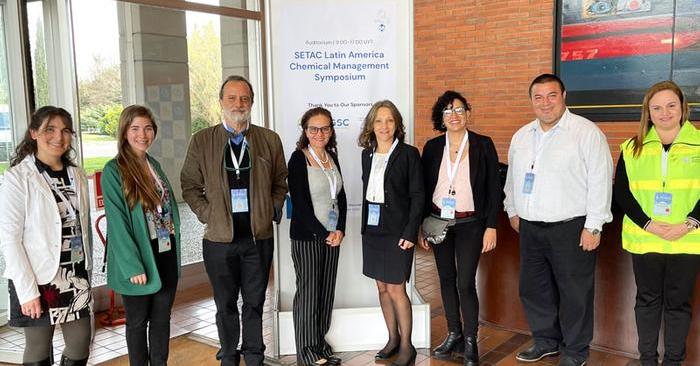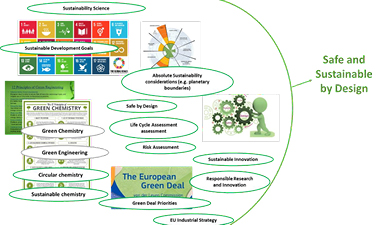Advancing Science Informed Decision Making in Chemical Management in the Latin America Region
Adriana Bejarano, Tamar Schlekat, and Chris Schlekat, organizing committee members of the SETAC Latin America Chemical Management Symposium
SETAC organized a day-long symposium ahead of the SETAC Latin America 15th Biennial Meeting 17–20 September in Montevideo, Uruguay. The symposium was organized as a follow-up to the Symposium on Chemicals Risk Assessment Approach and Needs for Latin America held in Santos, Brazil, in 2017. The symposium was developed to explore chemical management approaches in the legislations of Latin American countries and to identify scientific research needs in the region and opportunities for collaboration.
Regulatory experts from Latin America joined in person and shared the current status and key challenges of chemical management frameworks in their region. SETAC members presented best practices in chemical management and several case studies. Invited participants from all sectors were in attendance to learn and offer their perspectives. The symposium was held in three languages English, Spanish or Portuguese with the help of simultaneous interpreters.

The day started with a welcome from the meeting chair, Diana Migez, followed by a welcome from SETAC Latin America Board of Directors President Julie Brodeur. Immediately thereafter, Regulatory experts from six countries, Argentina, Brazil, Chile, Costa Rica, Peru, and Uruguay, shared some insight about some of the chemical management frameworks in their countries.
From the presentations given, there seems to be a clear focus on hazard-based chemical management in those Latin America countries, and it appeared that those countries manage chemicals through chemical inventories and registration as well as with emergency response plans in the case of Brazil. Several countries reported that many different ministries involved in chemical management which can be an advantage when there are strong inter-ministerial collaboration groups but can also be an issue when there is lack of cooperation and differing incentives and motivations. Most speakers emphasized the needs for collaboration and cooperation, capacity building, training and education, data and information sharing, including data transparency and traceability to support decision making, funding to fulfill regulatory requirements and international commitments.
SETAC invited speakers presented chemical management approaches and cases studies. Tamar Schlekat, SETAC Global Science Affairs Director, contrasted three chemical assessment approaches: hazard assessment, risk assessment and alternatives assessment, and how they can be applied in chemical regulations. This was followed with case studies and examples of applications in various industrial sectors. Ricardo Barra Rios, University of Concepción, Chile, talked about case studies related to aquaculture, followed by Juan Carlos Torres, Ciclo de Vida Consultores, who discussed examples from the mining industry. Then, Adriana Bejarano from Shell, gave examples related to petrochemicals, and finally, Ximena Patino from Bayer discussed case studies from the agrochemicals. Common themes included the importance of multistakeholder dialogue, intradisciplinary collaboration, and transparency, as well as the need for simplifying chemical management strategies.
Towards the end of the day, organizers distilled some notes and take-home messages briefly summarized here.
Acknowledge differences
It was clear that one size does not fit all. While it is reasonable to adapt existing regulations and frameworks, these need to be adapted to meet country-specific needs and evolving priorities, including consideration of extrinsic factors (e.g., climate, biodiversity). This is one of the reasons why many countries have ratified international conventions but have delayed their implementation as agreements need to be adjusted to reflect local needs and priorities, and compliance with existing laws. Consequently, each country brought specific considerations based on country-specific chemical type, use and scale. For example, Uruguay noted having have limited chemical footprints, and thus they focus on specific high-profile concerns such as lead and mercury. Brazil on the other hand has large gas and minerals operations that demand a focus on preventing catastrophic events and developing cross-sectoral and coordinated short- and long-term emergency responses to accidental releases. Costa Rica shared a focus on pesticide registration processes, which includes recognition of experiences gathered from other OECD member countries.
It was also noted that different industry sectors require specialized assessment approaches. For example, while pesticides and petroleum hydrocarbons are both organic substances, their intrinsic hazardous and persistency characteristics vary greatly, and thus different approaches are required. Likewise, it was observed that metals and inorganic substances are different from pesticides and petroleum hydrocarbons and thus require other specialized approaches.
Celebrate similarities
Almost every speaker stressed the need for transparency and broad multi-sectoral participation in chemical management. This is easier said than done, as it must be accepted that different sectors have different interests. Therefore, making these differences transparent and setting aside biases is also important. It was also widely agreed upon that a pragmatic approach is needed in terms of managing change and facilitating progress. For example, it is necessary to allow practical time for private sector implementation.
With regards to access to data and information, several speakers indicated the need for enabling technological advances, such that that online chemical inventories and tools can be used to both leverage information and enable effective chemical and waste management. This information is also needed to support decision making. Improving data sharing and acceptance among Latin American countries will reduce redundancies and duplication of effort, while maximizing limited resources. Speakers also underscored the importance of considering Indigenous and traditional knowledge needs when framing frameworks and delineating priorities.
Underscore state of the science approaches in chemical management
Several speakers called for making use of tiered approaches - beginning with simple screens based on both hazard and risk and progressing to more detailed assessment as needed. At the same time, it was underscored that conservatism needs to be balanced with real world information in later tiers. A few speakers also touched on the role of life cycle and recognized the benefits of circular economy principles. Finally, a call for pragmatism and using the weight-of-evidence approach as a way of thinking was encouraged. Taking advantage of experiences of other countries or organizations (e.g., OECD) was encouraged to increase efficiency of decision making in terms of resources and time – not to mention reduce need for animal testing. It was clear to all that SETAC can act as the “information broker” by “translating” rigorous chemical management approaches into forms that are easily understood and accessible to decision makers and broader society such as in SETAC Fact Sheets.
Participants in the symposium were clearly energized and called for SETAC to continue to promote dialogue and knowledge transfer among stakeholders and organize virtual networking and training events to advance chemical management in the region. SETAC offers a unique platform and opportunities for debate as a society that embraces multi-stakeholder multi-sector engagement to achieve shared goals.
Acknowledgement: The symposium occurred with financial support from Global Silicone Council (GSC), Metals Environmental Research Associations (MERA), and Bayer who funded attendance of regulators to the symposium and the meeting.
Author's contact: [email protected]





